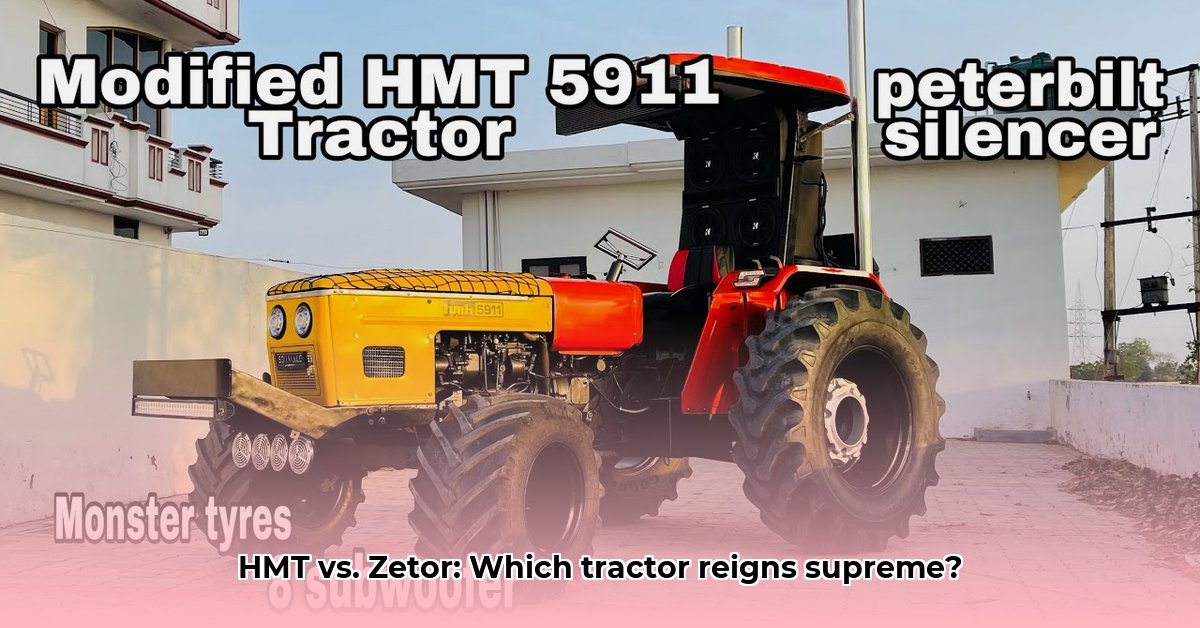
5911 Tractor: HMT vs. Zetor – A Detailed Comparison
The HMT 5911 and Zetor 5911 tractors represent a fascinating case study in agricultural machinery evolution. While sharing a common lineage—the original Zetor design—they diverged based on the unique demands of their respective markets. This deep dive compares their specifications, explores their historical context, and provides practical advice for maintaining these iconic workhorses. Did market adaptation truly improve the HMT 5911, or did it compromise certain aspects of the original Zetor design? This is a key question we'll address. For a comparison of a different classic tractor, see the Ford 3600 specifications.
Under the Hood: Engine Performance and Reliability
Both the HMT and Zetor 5911 tractors boast powerful, four-cylinder engines, delivering approximately 58-59 horsepower at 2200 RPM. This robust design, originally engineered by Zetor, is the backbone of their reliability. But how did their performance compare in real-world applications? Did the HMT's modifications affect this core strength?
Transmission and Gear Ratios: Navigating the Fields
Both models feature a manual transmission with 10 forward and 2 reverse gears, offering versatility in diverse terrains. However, HMT later introduced a high-speed transmission option, suggesting a focus on increased speed and efficiency. Did this adaptation prove successful, and did it alter the original Zetor's handling characteristics?
Fuel Efficiency and Tank Capacity: A Balancing Act
The HMT 5911 initially sported a 76-liter fuel tank, later reduced to 70 liters, presumably to improve fuel efficiency and reduce overall weight. This adjustment, specific to the Indian market, raises questions about the trade-off between fuel economy and operational convenience. Did this modification successfully balance the needs of the Indian farmer?
Lifting Capacity: Powering Through Heavy-Duty Tasks
Both tractors exhibit impressive lifting capacities, with the HMT capable of lifting 1700 kg and the Zetor approximately 1750 kg. These figures highlight the inherent strength of the design, enabling them to handle a wide range of heavy implements. Given these similar capacities, were other factors more influential in consumer preference?
Beyond the Specifications: A Study in Adaptation
The HMT 5911's story is one of adaptation. HMT significantly modified the original design, changing its exterior color from orange to black and upgrading its transmission. These weren't minor tweaks; they were major updates, reflecting a deep understanding of the Indian agricultural landscape. These adaptations, however, beg the question: how effectively did these modifications improve the performance and longevity of the tractor in its specific operating environment?
The HMT 5911's Legacy: A Discontinued Classic
The discontinuation of the HMT 5911 highlights the dynamic nature of the agricultural machinery market. Newer models with improved fuel efficiency and advanced features inevitably replace older designs. However, it also emphasizes the importance of sourcing replacement parts, a challenge for older, discontinued equipment. How can owners ensure the longevity of their HMT 5911s in the face of parts obsolescence?
HMT 5911 vs. Zetor 5911: A Side-by-Side Comparison
| Feature | HMT 5911 | Zetor 5911 | Key Differences |
|---|---|---|---|
| Engine | 4-cylinder, Zetor design | 4-cylinder, Zetor design | Minimal initial differences; long-term reliability to be considered. |
| Transmission | 10F + 2R Manual; later high-speed option | 10F + 2R Manual | HMT's high-speed option suggests improved speed and efficiency. |
| Fuel Tank Capacity | 70-76 liters (varied) | Unspecified in available data | Significant difference likely reflecting market-specific adaptations and prioritizations. |
| Lifting Capacity | 1700 kg | ~1750 kg | Minimal difference; both designed for heavy-duty tasks. |
Please note: This data represents a summary based on currently accessible information. Further research may uncover additional details.
Choosing Your 5911: Factors to Consider
The choice between an HMT 5911 and a Zetor 5911 depends on individual needs and priorities. Availability of spare parts—especially crucial for the discontinued HMT—repair costs, and the overall condition of the used tractor are key decision points. Will you opt for a readily supported machine or take a chance on a potentially harder-to-maintain model?
Securing Replacement Parts for the HMT 5911
Finding parts for a discontinued HMT 5911 requires a proactive approach. The key is to diversify your search strategy, exploring multiple avenues.
Strategies for Sourcing Parts
Online Marketplaces: Utilize online marketplaces specializing in agricultural equipment parts (e.g., IndiaMart 1). Be precise in your searches.
Specialized Dealers: Contact independent dealers specializing in older tractor models. Their networks often extend to salvage yards and individual part suppliers.
Scrap Yards: Explore local scrap yards and salvage operations handling agricultural machinery.
Remanufacturing: Consider remanufacturing worn parts with the help of a skilled mechanic.
Comparing Parts Across Similar Models
Investigate other tractors from the same era to identify potentially interchangeable parts. This approach could significantly expand your options, but always verify compatibility scrupulously.
Critical Considerations
- Quality: Prioritize quality parts to avoid future costly repairs.
- Compatibility: Verify part compatibility before purchase to prevent malfunctions.
- Cost: Account for part cost, shipping, and potential installation fees.
- Warranty: Seek warranties or guarantees, especially for used parts.
Key Takeaway: A multi-pronged approach and thorough due diligence are essential to successfully securing replacement parts for your HMT 5911. The future of parts availability for older models is ever-changing and demands careful planning.